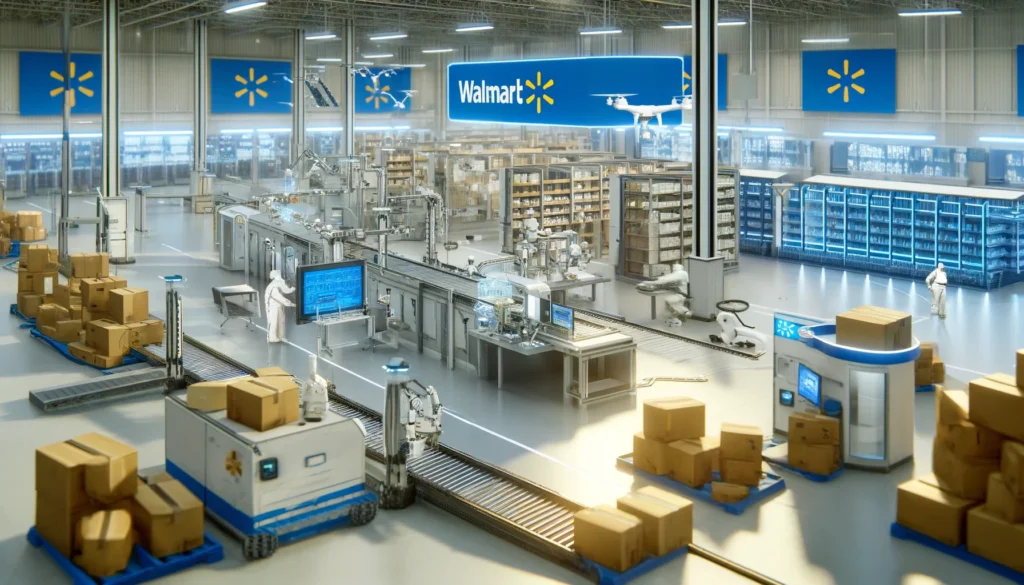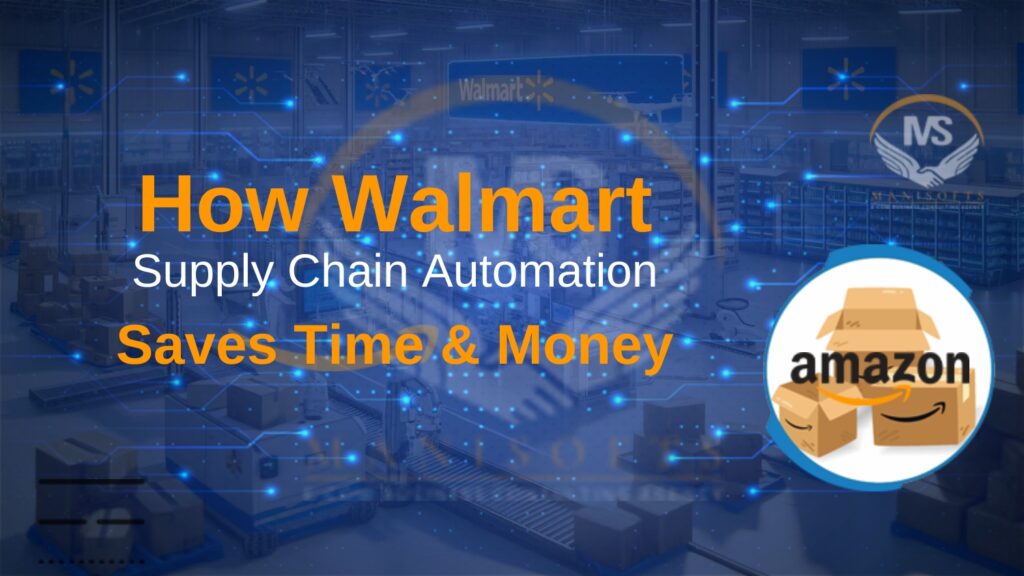Discover how Walmart is revolutionizing retail efficiency with cutting-edge supply chain automation! Explore benefits, technologies, and the future of automation for Walmart.
Introduction
World’s largest retailer, Walmart, is constantly exploring innovational strategies to remain on top, and its operational processes, especially supply chain protocols, are no exception. Walmart Supply Chain Automation is a combination of robotics, artificial intelligence , and machine learning application in daily operations for processing optimization, increased accuracy and efficiency. As the consumers’ requirements become more demanding and expedited, and affordable delivery becomes essential, automation is the solution. This overview of Walmart’s supply chain automation reveals how a leading retailer utilizes advanced technologies to transform logistics, inventory procedures, and customer service, paving the way for the industry.
Walmart Supply Chain Automation
Supple chain automation at Walmart has shown considerable progress, especially in efficiencies, cost reduction and achieving customer satisfaction. Some of what Walmart has done in supply chain automation includes:
1. Automated Warehouses: Revolutionizing Storage and Retrieval
To this end, Walmart has notably invested in state-of-the-art and highly automated distribution centers. Typically, the facilities have a massive adoption of advanced robotics such as Automated Guided Vehicles and Autonomous Mobile Robots that roam around the warehouse environment to quickly transport goods. For example, the company recently introduced Alphabot, a comprehensive but fully automated solution that picks, packs, and delivers items to an employee so that they can fulfill an individual order. Even though the end of the day is faster, Alphabot eliminates or significantly reduces labor costs and errors.
Benefits:
- Increased Efficiency: Robots can operate 24/7 without breaks, significantly boosting throughput.
- Reduced Labor Costs: Automation reduces the need for manual labor, cutting operational costs.
- Improved Accuracy: Automated systems minimize human error, ensuring accurate order fulfillment.
2. Autonomous Vehicles: The Future of Logistics
Walmart is currently running pilot projects to use unmanned trucks, also known as autonomous trucks, in middle and last-mile delivery. Walmart works with its tech partners Gatik and Nuro to test self-driven trucks to deliver goods between outlets and warehouses.
- Middle-Mile Automation: Gatik autonomous box trucks for marsh transb- port and distribution deliver from fulfilment centers to ac shops. The trucks provide a great fit for regular delivery due to their fixed and repeatable routes.
- Last-Mile Delivery: Nuro is also testing autonomous delivery vehicles for local deliveries in a partnership with Walmart. It involves self-driving, small vehicles that go around the city streets ensuring the delivery of groceries and goods right to the customers’ doorstep.
Benefits:
- Cost Reduction: Autonomous vehicles reduce reliance on human drivers, lowering labor costs.
- Enhanced Safety: Advanced sensors and AI systems can potentially reduce accidents caused by human error.
- Efficiency Gains: Autonomous vehicles can operate continuously, improving delivery speed and reliability.
3. Robotic Process Automation (RPA): Streamlining Back-Office Operations
For its back-office operations, Walmart opts to use robots to perform repeatable duties. RPA bots are programmed to perform data entry, invoice processing, and inventory management. For example, the robots also update the inventory system in real-time according to what is selling and when they sell and restocks products.

Benefits:
- Operational Efficiency: RPA reduces the time required for routine tasks, freeing up employees for more strategic work.
- Error Reduction: Automation minimizes human errors in data entry and processing.
- Cost Savings: By automating mundane tasks, Walmart can reduce the operational costs associated with manual labor.
4. Artificial Intelligence (AI) and Machine Learning (ML): Optimizing Supply Chain Management
AI and ML play a crucial role in optimizing various aspects of Walmart’s supply chain. These technologies are used for demand forecasting, inventory management, and route optimization.
- Demand Forecasting: AI algorithms analyze historical sales data, seasonal trends, and external factors (e.g., weather, holidays) to predict future demand. This helps Walmart maintain optimal inventory levels, reducing overstock and stockouts.
- Inventory Management: ML models monitor inventory in real-time, automatically triggering restock orders when levels fall below a certain threshold.
- Route Optimization: AI-powered systems analyze traffic patterns and delivery routes to find the most efficient paths, reducing delivery times and fuel costs.
Benefits:
- Improved Accuracy: AI provides more precise demand forecasts, enhancing inventory management.
- Cost Efficiency: Optimized routes and inventory levels reduce operational costs.
- Enhanced Customer Satisfaction: Accurate forecasting and efficient deliveries ensure products are available when and where customers need them.
5. Blockchain Technology: Enhancing Transparency and Traceability
Walmart has implemented blockchain technology to improve the traceability of its food supply chain. By partnering with IBM, Walmart uses the IBM Food Trust blockchain to track the journey of food products from farm to store shelf. This system allows Walmart to quickly trace the origin of products, ensuring food safety and quality.
Benefits:
- Enhanced Transparency: Blockchain provides a tamper-proof record of the product’s journey, ensuring accountability.
- Quick Recalls: In case of a food safety issue, Walmart can quickly identify and remove affected products from shelves.
- Consumer Trust: Increased transparency builds consumer confidence in the safety and quality of Walmart’s products.
6. Internet of Things (IoT): Real-Time Monitoring and Tracking
IoT devices play a critical role in monitoring and tracking goods throughout Walmart’s supply chain. Sensors and RFID tags provide real-time data on the location, condition, and temperature of products.
- Temperature Monitoring: For perishable items, IoT sensors monitor temperature and humidity levels during transportation and storage, ensuring products remain fresh.
- Location Tracking: GPS-enabled devices track the location of shipments, providing real-time visibility into the supply chain.
Benefits:
- Quality Assurance: Continuous monitoring ensures products are stored and transported under optimal conditions.
- Real-Time Visibility: Real-time tracking improves supply chain transparency and helps prevent delays.
- Proactive Issue Resolution: Early detection of issues (e.g., temperature deviations) allows for prompt corrective actions.
7. Smart Shelves: Automated Inventory Management
Walmart uses smart shelves equipped with weight sensors and cameras to monitor inventory levels in real-time. These shelves can automatically detect when items are running low and trigger restock alerts.
Benefits:
- Reduced Stockouts: Automated alerts ensure timely restocking, reducing the likelihood of stockouts.
- Inventory Accuracy: Real-time monitoring provides accurate inventory data, improving overall inventory management.
- Labor Efficiency: Automated systems reduce the need for manual inventory checks, freeing up staff for other tasks.
8. Automated Checkout Systems: Enhancing the Customer Experience
To improve the in-store shopping experience, Walmart has implemented automated checkout systems. These systems use computer vision and machine learning to scan items and process payments quickly and accurately.
Benefits:
- Faster Checkouts: Automated systems reduce checkout times, minimizing wait times for customers.
- Labor Savings: Self-checkout reduces the need for cashier staff, lowering labor costs.
- Improved Accuracy: Advanced scanning technology reduces the risk of errors during the checkout process.
Impact of Walmart’s Supply Chain Automation
Operational Efficiency:
Walmart’s automation initiatives have significantly enhanced operational efficiency across its supply chain. Automated systems and AI-driven optimizations reduce processing times, minimize errors, and ensure smoother operations.
Cost Reduction:
By automating various aspects of its supply chain, Walmart has been able to cut labor costs, reduce fuel expenses, and minimize waste. These cost savings contribute to Walmart’s ability to offer competitive prices to customers.
Customer Satisfaction:
Improved efficiency and accuracy in inventory management and order fulfillment result in better product availability and faster delivery times. Enhanced transparency and quality assurance measures build consumer trust and satisfaction.
Sustainability:
Automation helps Walmart reduce its environmental footprint by optimizing transportation routes, minimizing waste, and improving energy efficiency in warehouses and stores.
FAQ’s
Automation enables Walmart to quickly adapt to supply chain disruptions by using real-time data analytics to modify inventory distribution and logistics strategies effectively.
Challenges include the high initial investment in technology, the ongoing need for employee training and adaptation, and the complexity of integrating new systems with existing infrastructure.
Automation provides precise tracking and predictive analytics, allowing Walmart to maintain optimal inventory levels and reduce overstock or stockouts, thereby maximizing shelf availability and minimizing waste.
While other retailers can implement similar technologies, the scale and integration level of Walmart’s automation are built on a massive, global network and a big data foundation that might be difficult for smaller players to replicate.
Future enhancements may include greater use of machine learning for deeper insights into consumer behavior, more advanced robotics in warehouses and stores, and increased use of sustainable technologies to minimize environmental impact.
Conclusion
In the realm of global retail, Walmart has consistently led the way in scaling operations efficiently, a feat largely enabled by its pioneering efforts in supply chain automation. Walmart’s supply chain, one of the most powerful in the world, leverages advanced technologies and innovative practices to ensure that millions of products reach its stores and customers with remarkable speed and accuracy. This commitment to automation not only streamlines operations but also significantly reduces costs and improves customer satisfaction by ensuring product availability and timely delivery.
As retail environments grow increasingly competitive and digital, Walmart continues to invest in new technologies and strategies, setting industry standards in supply chain management and operational excellence. Through the integration of robotics, artificial intelligence, and real-time data analytics, Walmart’s supply chain automation stands as a critical component of its business strategy, ensuring resilience and adaptability in a rapidly changing market landscape.




